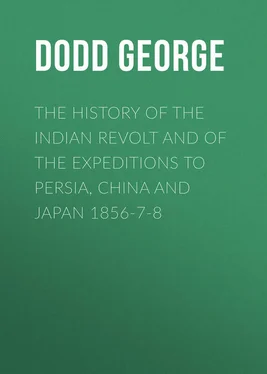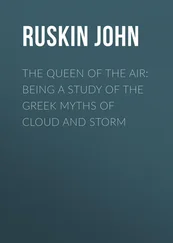George Dodd - The History of the Indian Revolt and of the Expeditions to Persia, China and Japan 1856-7-8
Здесь есть возможность читать онлайн «George Dodd - The History of the Indian Revolt and of the Expeditions to Persia, China and Japan 1856-7-8» — ознакомительный отрывок электронной книги совершенно бесплатно, а после прочтения отрывка купить полную версию. В некоторых случаях можно слушать аудио, скачать через торрент в формате fb2 и присутствует краткое содержание. Жанр: foreign_antique, foreign_prose, на английском языке. Описание произведения, (предисловие) а так же отзывы посетителей доступны на портале библиотеки ЛибКат.
- Название:The History of the Indian Revolt and of the Expeditions to Persia, China and Japan 1856-7-8
- Автор:
- Жанр:
- Год:неизвестен
- ISBN:нет данных
- Рейтинг книги:3 / 5. Голосов: 1
-
Избранное:Добавить в избранное
- Отзывы:
-
Ваша оценка:
- 60
- 1
- 2
- 3
- 4
- 5
The History of the Indian Revolt and of the Expeditions to Persia, China and Japan 1856-7-8: краткое содержание, описание и аннотация
Предлагаем к чтению аннотацию, описание, краткое содержание или предисловие (зависит от того, что написал сам автор книги «The History of the Indian Revolt and of the Expeditions to Persia, China and Japan 1856-7-8»). Если вы не нашли необходимую информацию о книге — напишите в комментариях, мы постараемся отыскать её.
The History of the Indian Revolt and of the Expeditions to Persia, China and Japan 1856-7-8 — читать онлайн ознакомительный отрывок
Ниже представлен текст книги, разбитый по страницам. Система сохранения места последней прочитанной страницы, позволяет с удобством читать онлайн бесплатно книгу «The History of the Indian Revolt and of the Expeditions to Persia, China and Japan 1856-7-8», без необходимости каждый раз заново искать на чём Вы остановились. Поставьте закладку, и сможете в любой момент перейти на страницу, на которой закончили чтение.
Интервал:
Закладка:
What India was before the arrival of the Mussulmans, need not be told here at any length. We know, in truth, very little on that matter. It was from the days of the first Moslem conqueror that the greatness of Delhi began. Long before the Christian era, Arab merchants brought rich spiceries from Sinde and Malabar, and sold them to Phœnician merchants, who conveyed them on laden camels by way of Petra to the shores of the Mediterranean. Other portions of Indian merchandise were carried up the Persian Gulf and the Euphrates to a point whence they were transported westward to Aleppo or Antioch – a route almost identical with that advocated in the present day for a Euphrates railway and a Euphrates telegraph. The Greeks derived all their knowledge of Indian commodities through the Phœnicians: while their information concerning the country itself was obtained from the Persians, who at one time held sway as far as the Indus. The expedition of Alexander the Great into India, about 326 B.C., first gave the Greeks a personal knowledge of this wonderful land; and many successors of the great Macedonian added to the then existing amount of information concerning the tribes, the productions, the customs of the region beyond the Indus. Consequent on those discoveries, the merchants of the newly founded city of Alexandria gradually obtained a command of the trade with India: bringing the rich produce of the East by ship to Berenice on the Red Sea, and then transporting it overland to Alexandria. The commodities thus imported were chiefly precious stones, spices, perfumes, and silks; and during some centuries the Roman Empire was drained of much specie to pay for these imports. Alexandrians were the principal merchants who furnished the nations of Europe with Indian articles till the discovery of the passage round the Cape of Good Hope by Vasco de Gama in 1498. The western nations of Asia, however, continued to be supplied principally by the merchants of Basra or Bussorah, a very flourishing commercial city near the point where the Euphrates empties itself into the Persian Gulf; and there was also an extensive caravan-trade from Northern India through Northern Persia to the Caspian and the Black Sea. The discovery of the Cape of Good Hope route naturally attracted the attention of the maritime nations of Europe towards India, followed by the settlement of Portuguese and Dutch traders on the coast, and ultimately by the wonderful rise of British power in those regions through the instrumentality of the East India Company.
But although trading instincts thus laid India open to the commercial dealings of merchants, and to the cupidity of European princes, it was not until modern erudition had been applied to the subject that the true history of the land of the Hindoos became at all known. Scholars found, when they had mastered the Sanscrit or sacred language of that people, that a wonderful mine of information was thrown open to them. They ascertained that the nation, whatever it may have been called, from which the genuine Hindoos are descended, must at some period have inhabited the central plains of Asia, whence they migrated into the northern parts of India; that for at least a thousand years before the Christian era, great and powerful empires existed in Hindostan, which made considerable progress in knowledge, civilisation, and literature; that Southern India, or the Deccan, was conquered and peopled by the Hindoos at a much later date than the rest; that Buddhism, the religion of the earlier inhabitants, was overruled and driven out by Brahminism or Hindooism in the fifth century of our era; and that for five centuries longer, the Hindoos were the true rulers of this much-coveted land.
It was, however, as has been already implied, only with the arrival of the Mohammedans that the course of Indian history took that turn which is now interesting to us, especially in connection with the city of Delhi.
The year 1000 was marked by the invasion of India by Mahmoud of Ghiznee, a Tatar sovereign who held sway among the chieftains of Afghanistan. He defeated the rajah of Lahore at Peshawur; then penetrated beyond the Sutlej; and returned laden with spoil. In a second expedition he conquered Moultan; in a third, he reconquered the same city after a revolt. A fourth expedition found Mahmoud opposed by a confederacy of all the sovereigns of Northern India, who, seeing a common danger, resolved to unite for a common cause; they were rapidly gaining an advantage over him, when the sudden fright of an elephant induced a panic in the Hindoo army, and left the victory to Mahmoud, who returned to Ghiznee still more richly laden with booty than ever. For a time, the Hindoo king who reigned over the region of which Delhi was the chief city, managed to ward off the hostility of the great invader; but taking offence at a departure from neutrality during one of the later expeditions, Mahmoud captured that city, and returned to Ghiznee with forty thousand prisoners. For thirty years did these raids and spoliations continue. The most celebrated next to that which resulted in the sack of Delhi, was the expedition intended for the destruction of the Hindoo temple of Somnauth in Gujerat: a temple which, if native annals are to be believed, had fifty thousand worshippers, and was endowed with a revenue of two thousand villages; which had two thousand Brahmins officiating as priests, five hundred daughters of noble Hindoos as dancing-girls, three hundred musicians; and the sandal-wood gates of which were the theme of magniloquence from the pen of an English governor-general eight centuries afterwards. 6 6 When General Nott returned to India after his victorious campaign in Afghanistan in 1842, he brought away with him the gates of Somnauth, which, according to the tradition, had remained at Ghiznee since the days of Mahmoud. This and other trophies gave occasion to an address from Lord Ellenborough to the native princes of India, conceived in somewhat bombastic language, in which the recapture of the gates was characterised as an achievement ‘avenging the insult of eight hundred years.’ The chiefs and princes of Sirhind, Rajwarra, Malwah, and Gujarat, were enjoined to transmit, ‘with all honour,’ the gates to Somnauth. The address was much ridiculed in England; but those on the spot believed it to be calculated to make an impression on the natives. The home government, however, would not permit the gates – even if the genuine sandal-wood originals, which is not free from doubt – to be sent to the still-existing temple of Somnauth; they considered such an act would identify the Company injuriously with one of the two great parties of religionists in India, and deeply offend the other.
Mahmoud broke all the idols, and carried off countless treasures to Ghiznee.
From that time to the period of the rise of British power, the Mohammedans never lost their hold upon India, however much it may have been shaken by occasional success on the part of the Hindoos; nor did they ever cease to regard Delhi as the chief Indian city. Although Mahmoud made twelve expeditions across the Indus, the object was mainly booty, rather than permanent settlement. His successors, however, established a regular government in the Punjaub, and in the region thence eastward to Delhi. The Ghiznee dynasty was put an end to in the year 1184, when it was overcome by the Seljuks; and in 1193 Delhi was formally appointed capital of the Moslem sovereigns of India. After a succession of rebellions and murders, exhibiting all the hideous features of Oriental politics, the Seljuk dynasty fell to pieces in the year 1289. Then arose a third Mohammedan dynasty, that of the Afghans or Patans, who came like all the other conquerors of India from the northwest, and who like them coveted Delhi as their capital. For about a century did these Patan emperors reign, continually struggling against Hindoo rajahs on the one hand, and Mussulman adventurers on the other.
Читать дальшеИнтервал:
Закладка:
Похожие книги на «The History of the Indian Revolt and of the Expeditions to Persia, China and Japan 1856-7-8»
Представляем Вашему вниманию похожие книги на «The History of the Indian Revolt and of the Expeditions to Persia, China and Japan 1856-7-8» списком для выбора. Мы отобрали схожую по названию и смыслу литературу в надежде предоставить читателям больше вариантов отыскать новые, интересные, ещё непрочитанные произведения.
Обсуждение, отзывы о книге «The History of the Indian Revolt and of the Expeditions to Persia, China and Japan 1856-7-8» и просто собственные мнения читателей. Оставьте ваши комментарии, напишите, что Вы думаете о произведении, его смысле или главных героях. Укажите что конкретно понравилось, а что нет, и почему Вы так считаете.












